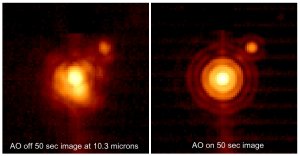

This picture is a close up of the Orion nebula as you’ve never seen it before – the sharpest image of Orion ever taken. This image wasn’t taken by Hubble, or Chandra, or any of our other space-based observatories. Instead, this image was taken by an Earth-based telescope. The image itself is a technological demonstration of a fantastic new feature available for Earth-based telescopes – the Adaptive Secondary Mirror (ASM).
Ground-based telescopes have always dealt with atmospheric turbulence and other anomalies in the atmosphere that make ground-based observing very hard. The atmosphere manages to disrupt our view, handicapping many of the world’s most powerful telescopes. The ASM technology eliminates that atmospheric disturbance allowing ground-based telescopes to approach their theoretical observing limits. This technology allows telescopes that have main mirrors with larger diameters to operate just like a space-based telescope. We can essentially triple or quadruple the type of visible light quality we accept from Hubble with the application of this new method.

The entire package is called MagAO (for Magellan Adaptive Optics). The first test for the technology revolved around Theta 1 Ori 2 – a binary pair orbiting very close to one another (the stars are about the same distance apart as Earth and Uranus are). The binary system is so close, in fact, that scientists have been having a hard time verifying the system as a binary instead of one star. The new picture was able to resolve the binary pair as two distinct stars – a major win for technology.
Now, with our vast array of ground-based telescopes, we can systematically upgrade them with the new MagAO technology to allow for some stunning visible-light science. Other types of observing (like infrared) could make a little use of this technology, but not much. That deals with how infrared light interacts with the atmosphere which works beyond simply ‘blurring’ from atmospheric disturbances.